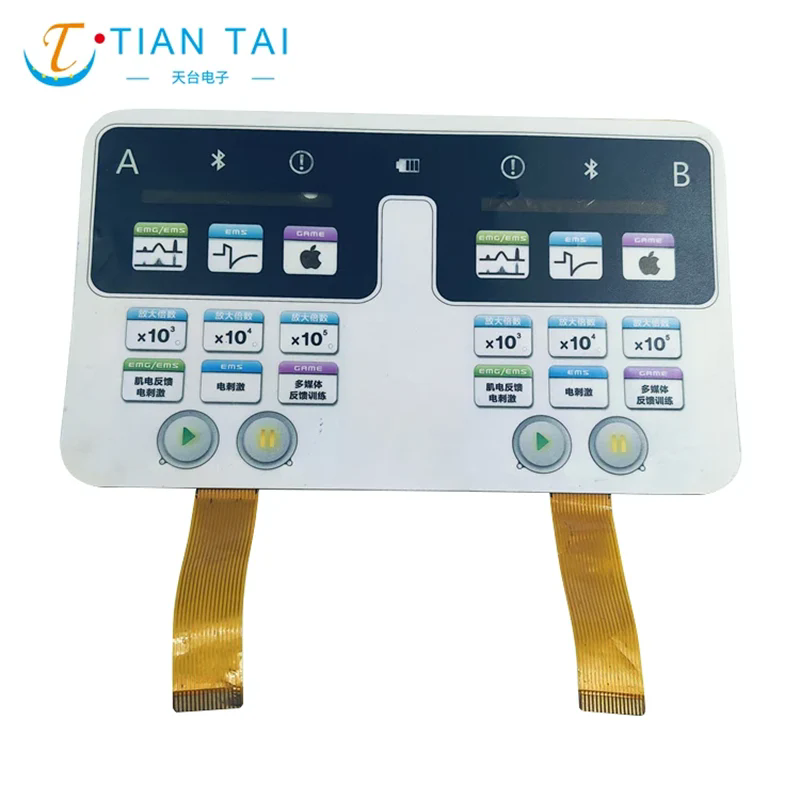Membrane Switch Keypad: The Ultimate Solution for User Interface Control
2025-03-18
In today’s technologically advanced world, the need for compact, durable, and efficient user interfaces is greater than ever. Whether it's for medical devices, household appliances, or industrial machinery, a reliable and intuitive control system is essential. One solution that has gained widespread popularity across various industries is the membrane switch keypad.
In this blog, we'll explore what membrane switch keypads are, their benefits, common applications, and how they are revolutionizing user interface design in numerous sectors.
What is a Membrane Switch Keypad?
A membrane switch keypad is a type of electrical switch that uses a flexible, laminated membrane to control the functions of a device. It consists of several layers that are fused together, with each layer serving a specific purpose. The most important layers include the circuit layer, graphic overlay, and adhesive backing. These layers work together to create a durable, responsive, and easy-to-use control system.
When a key on the membrane switch is pressed, the circuit layer closes the electrical contact beneath it, sending a signal to the device’s processor. The result is an action, such as turning on a light, adjusting the temperature, or activating a function in a machine.
Why Choose a Membrane Switch Keypad?
1. Durability and Longevity
One of the standout features of membrane switch keypads is their exceptional durability. Unlike traditional mechanical switches, which have moving parts and can wear down over time, membrane switches are constructed from flexible materials that can withstand a significant amount of pressure and use. The lack of moving parts makes them highly resistant to wear and tear, ensuring a longer lifespan.
Additionally, membrane switches are resistant to environmental factors such as dust, moisture, and dirt, making them ideal for harsh environments like industrial settings, medical equipment, and outdoor applications.
2. Compact and Space-Saving Design
The slim profile of membrane switch keypads makes them an excellent choice for devices with limited space. Since they are designed to be flexible and lightweight, membrane switches can be incorporated into a wide variety of applications without adding significant bulk. This makes them ideal for consumer electronics, portable devices, and even small household appliances.
The compact nature of membrane switches also makes them suitable for custom designs. They can be manufactured in different shapes and sizes, which gives engineers the flexibility to create unique and innovative user interfaces for specific products.
3. Cost-Effective Solution
For manufacturers looking for an affordable user interface option, membrane switch keypads are a cost-effective solution. The manufacturing process of these switches is relatively simple and low-cost compared to more complex alternatives, such as mechanical switches or touchscreens. Despite their affordability, membrane switches deliver reliable performance, making them a great option for businesses on a budget.
4. Versatility and Customization
Membrane switch keypads are incredibly versatile and can be customized to suit a wide range of applications. They can feature a variety of button configurations, colors, and graphics to match the specific needs of a product. Manufacturers can add LED backlighting, embossing, and even tactile feedback to improve the user experience.
This level of customization ensures that membrane switches can be integrated into nearly any device, from simple household electronics to high-tech medical equipment and industrial machinery.
5. Easy to Clean and Maintain
Since membrane switches don’t have gaps between the keys, they are much easier to clean compared to traditional mechanical switches. This makes them especially useful in environments where hygiene is a priority, such as medical equipment, food processing machines, and laboratory devices. A simple wipe-down with a damp cloth is often sufficient to keep the keypad in good condition.
Common Applications of Membrane Switch Keypads
1. Consumer Electronics
Membrane switch keypads are commonly used in consumer electronics, including microwave ovens, washing machines, televisions, and remote controls. Their low-profile design, ease of use, and ability to withstand frequent interaction make them ideal for everyday devices. Many household products now feature membrane switches due to their sleek appearance and efficient functionality.
2. Medical Devices
In the medical field, reliability and durability are paramount. Membrane switch keypads are frequently found in medical devices such as infusion pumps, diagnostic machines, and patient monitoring systems. These switches can be designed to meet strict hygiene standards, making them a perfect choice for healthcare settings. They are also capable of withstanding exposure to harsh cleaning agents and fluids.
3. Industrial Equipment
In industrial applications, membrane switch keypads are used to control machinery, equipment, and various automated systems. These keypads are well-suited for environments where dust, moisture, and dirt are present. Additionally, their tactile feedback and ability to operate in extreme temperatures make them ideal for factories, control panels, and HVAC systems.
4. Automotive Industry
The automotive industry utilizes membrane switch keypads for various functions, such as controlling climate control systems, entertainment systems, and dashboard buttons. Their ability to withstand vibrations, temperature fluctuations, and exposure to oils and chemicals makes them a great option for automotive interiors.
5. Aerospace and Military Applications
In high-stakes environments like aerospace and military operations, reliability is critical. Membrane switch keypads are used in control panels for aircraft, satellites, and military-grade equipment. Their ability to resist extreme conditions, such as high altitudes and rapid temperature changes, ensures that they perform well in the most demanding environments.
How Membrane Switch Keypads Work
Membrane switch keypads operate on a simple principle: when a key is pressed, it completes an electrical circuit that triggers an action in the device. The structure of the membrane switch typically includes several layers:
1. Top Layer (Graphic Overlay): This is the visible surface of the keypad, where buttons are marked and labeled. The overlay can be customized with symbols, text, or logos.
2. Circuit Layer: This layer contains conductive traces that form the electrical circuit. Each button is part of the circuit, and pressing it connects the conductive traces, sending a signal to the device.
3. Spacer Layer: This layer separates the circuit from the bottom layer and prevents accidental contact between the two.
4. Bottom Layer: This is the layer that makes contact with the underlying circuitry, completing the circuit when the key is pressed.
When the membrane switch is activated, it sends an electrical signal to the controller, which then processes the input and carries out the corresponding function.
Conclusion
Membrane switch keypads are an indispensable component of modern user interface design, offering durability, compactness, and cost-effectiveness without sacrificing performance. Their versatility and customization options make them suitable for a wide range of applications, from consumer electronics to industrial machinery and medical devices.
As technology continues to evolve, membrane switches remain a reliable choice for manufacturers seeking to create intuitive, durable, and user-friendly devices. If you’re looking for a high-performance, affordable, and customizable solution for your next project, a membrane switch keypad is a great option to consider.



